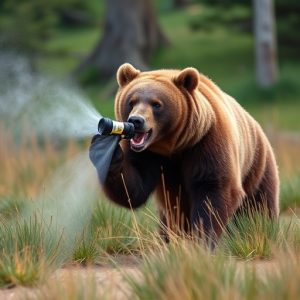Maximizing Bear Spray Effectiveness: Legal Considerations and Safety Tips
Bear spray is a vital safety tool in bear-inhabited areas, using capsaicin to repel bears and provid…….
Bear spray is a vital safety tool in bear-inhabited areas, using capsaicin to repel bears and provide escape time. However, navigating the varied legal requirements for its possession, use, and storage across US states is essential for both legality and effectiveness. Understanding local regulations, concentration levels, application techniques, and specific bear species ensures optimal protection while exploring wilderness regions with bear activity. Always research Bear Spray Legal Requirements by State before venturing into such areas.
“Uncovering the Maximum Stopping Power of Bear Spray: A Comprehensive Guide to Defense and Safety. Bears, a powerful symbol of nature, can pose significant risks in certain regions. This article explores bear spray, a popular self-defense tool, delving into its composition, effectiveness, and legal considerations across states. We’ll break down factors influencing its stopping power, offer region-specific guidance, and emphasize safe handling practices. Understanding the legal requirements for bear spray by state is crucial before venturing into areas where bears roam. Stay informed, stay safe.”
- Understanding Bear Spray: Composition and Effectiveness
- Legal Status of Bear Spray: Federal vs State Regulations
- Maximum Stopping Power: Factors Influencing Bear Spray's Efficacy
- Choosing the Right Bear Spray for Your Region
- Safety Measures and Responsible Use of Bear Spray
Understanding Bear Spray: Composition and Effectiveness
Bear spray, also known as bear repellent, is a crucial tool for individuals navigating wilderness areas where bears are present. Its composition typically includes capsaicin, the active ingredient found in chili peppers, along with various other chemical agents. These ingredients create an irritant that triggers a reaction in bears, causing them to retreat. The effectiveness of bear spray lies in its ability to create a temporary but powerful deterrent, allowing users precious time to escape or defend themselves.
When considering bear spray’s maximum stopping power, it’s essential to understand the legal requirements for carrying and using it vary by state. Each US state has specific regulations regarding where and how bear spray can be carried, used, and stored. For instance, some states require permits for possession, while others have restrictions on the type of spray allowed. Being aware of these legal considerations is vital for ensuring compliance and maximizing the defensive capabilities of bear spray during encounters in bear country.
Legal Status of Bear Spray: Federal vs State Regulations
In many parts of North America, bear spray is a widely used personal defense tool against aggressive bears. However, its legal status varies significantly across different states and federal territories. Understanding these regulations is crucial for anyone venturing into bear country, as possession and use can be subject to strict rules. At the federal level, the U.S. National Park Service and other agencies have established guidelines for carrying bear spray, often specifying types approved for use and restrictions on where and how it can be carried.
When it comes to Bear Spray Legal Requirements by State, regulations differ widely. Some states allow citizens to carry bear spray without a permit, while others mandate permits or licenses. Additionally, there are variations in the types of spray permitted, allowed concentrations, and even age restrictions for purchase and possession. For instance, California requires bear spray to be registered, while other states may have specific rules regarding the expiration dates of permits or the minimum distance one must keep from bears while using spray. Staying informed about these local laws is essential for ensuring compliance and maximizing personal safety in bear-inhabited areas.
Maximum Stopping Power: Factors Influencing Bear Spray's Efficacy
Bear spray, also known as bear repellent, is designed to protect individuals from aggressive bear encounters in wild environments. When it comes to maximum stopping power, several factors influence the efficacy of bear spray. One key consideration is the concentration and type of capsaicin, the active ingredient that causes irritation and ultimately deters bears. Higher concentrations typically offer greater protection, but proper application is equally critical. The range and wind conditions during use can significantly impact its effectiveness; therefore, users must follow manufacturer instructions for optimal results.
Another essential aspect to consider is compliance with local laws and Bear Spray Legal Requirements by State. Different states have varying regulations regarding the type, quantity, and availability of bear spray. Some areas may mandate specific concentrations or brand approvals, while others might restrict carrying bear spray in certain parks or wilderness regions. Staying informed about these requirements ensures legal compliance and enhances personal safety during outdoor activities in bear-inhabited areas.
Choosing the Right Bear Spray for Your Region
Choosing the right bear spray depends on your location and specific bear species present in the area. Bear spray effectiveness varies based on factors like canister size, concentration of capsaicin (the active ingredient), and weather conditions. Different states have varying legal requirements for bear spray ownership and usage. Before purchasing, research bear spray legal requirements by state to ensure compliance.
Consider local guidelines and recommendations from wildlife experts or park rangers. Some regions may suggest higher-concentration sprays for more aggressive bear encounters, while others might recommend lighter options due to environmental considerations. Always test your chosen bear spray in safe, controlled environments to familiarize yourself with its range, wind effects, and handling procedures.
Safety Measures and Responsible Use of Bear Spray
When carrying bear spray, understanding and adhering to local regulations is paramount for both safety and legal compliance. The use of bear spray varies by state, with some areas having strict rules on who can possess it, where it can be carried, and under what circumstances it can be deployed. For instance, some states require permits or registration for carrying bear spray, while others have specific seasons or zones where its use is prohibited. It’s crucial to research the Bear Spray Legal Requirements by State before venturing into wilderness areas known for bear activity.
Responsible use involves recognizing that bear spray is a tool of last resort and should only be deployed when facing an aggressive or defensive bear encounter. Misuse, such as spraying indiscriminately or from excessive distance, can lead to poor outcomes for both the individual and wildlife. Always practice proper handling techniques, stay calm, and follow recommended guidelines for optimal spray range and angle. Remember that even in areas where bear spray is legal, its use may be regulated based on local ecosystems and human-wildlife interactions.
Bear spray, while an important tool for personal defense against bears, is subject to varying legal requirements by state. Understanding both federal and state regulations, along with the factors influencing its effectiveness, is crucial for responsible use. Choosing the right bear spray tailored to your region ensures maximum stopping power when it matters most. Always prioritize safety measures and follow best practices for using bear spray to minimize risks and maximize its defensive capabilities.


